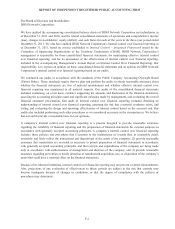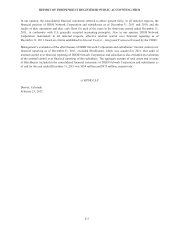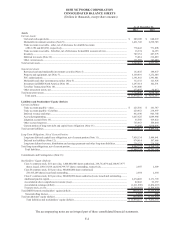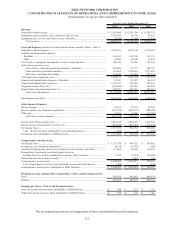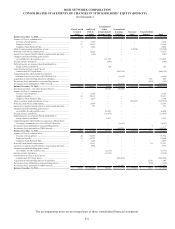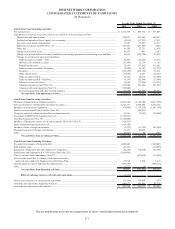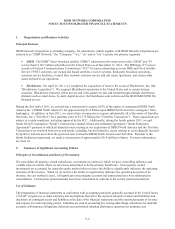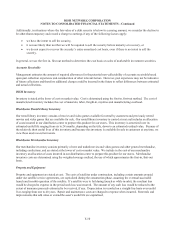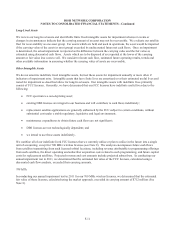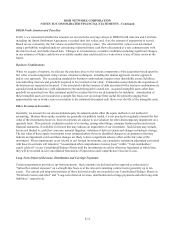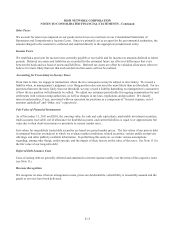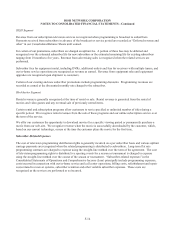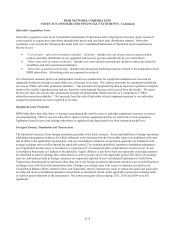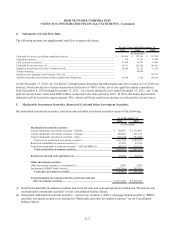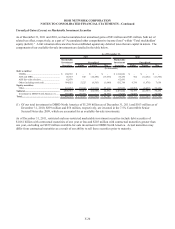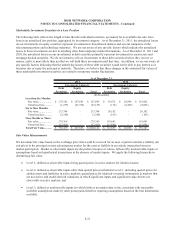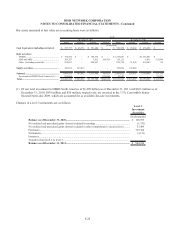Dish Network 2011 Annual Report Download - page 106
Download and view the complete annual report
Please find page 106 of the 2011 Dish Network annual report below. You can navigate through the pages in the report by either clicking on the pages listed below, or by using the keyword search tool below to find specific information within the annual report.DISH NETWORK CORPORATION
NOTES TO CONSOLIDATED FINANCIAL STATEMENTS - Continued
F-12
DBSD North America and TerreStar
In 2011, we considered whether the amounts we invested (the carrying values) in DBSD North America and TerreStar,
including the Sprint Settlement Agreement, exceeded their fair values and, if so, the amount of impairment to record.
Based on our evaluation, the fair values exceeded their carrying values. The estimated fair values were determined
using a probability weighted analysis considering estimated future cash flows discounted at a rate commensurate with
the risk involved, and market based data. Changes in circumstances or market conditions including significant changes
in our estimates of future cash flows or available market data could result in a write-down of any of these assets in the
future.
Business Combinations
When we acquire a business, we allocate the purchase price to the various components of the acquisition based upon the
fair value of each component using various valuation techniques, including the market approach, income approach
and/or cost approach. The accounting standard for business combinations requires most identifiable assets, liabilities,
noncontrolling interests and goodwill acquired to be recorded at fair value. Transaction costs related to the acquisition of
the business are expensed as incurred. Costs associated with the issuance of debt associated with a business combination are
capitalized and included as a yield adjustment to the underlying debt’s stated rate. Acquired intangible assets other than
goodwill are amortized over their estimated useful lives unless the lives are determined to be indefinite. Amortization of
these intangible assets are recorded on a straight line basis over an average finite useful life primarily ranging from
approximately one to twenty years or in relation to the estimated discounted cash flows over the life of the intangible asset.
Other Investment Securities
Generally, we account for our unconsolidated equity investments under either the equity method or cost method of
accounting. Because these equity securities are generally not publicly traded, it is not practical to regularly estimate the fair
value of the investments; however, these investments are subject to an evaluation for other-than-temporary impairment on a
quarterly basis. This quarterly evaluation consists of reviewing, among other things, company business plans and current
financial statements, if available, for factors that may indicate an impairment of our investment. Such factors may include,
but are not limited to, cash flow concerns, material litigation, violations of debt covenants and changes in business strategy.
The fair value of these equity investments is not estimated unless there are identified changes in circumstances that may
indicate an impairment exists and these changes are likely to have a significant adverse effect on the fair value of the
investment. When impairments occur related to our foreign investments, any cumulative translation adjustment associated
with these investments will remain in “Accumulated other comprehensive income (loss)” within “Total stockholders’
equity (deficit)” on our Consolidated Balance Sheets until the investments are sold or otherwise liquidated; at which time,
they will be recorded in our Consolidated Statements of Operations and Comprehensive Income (Loss).
Long-Term Deferred Revenue, Distribution and Carriage Payments
Certain programmers provide us up-front payments. Such amounts are deferred and recognized as reductions to
“Subscriber-related expenses” on a straight-line basis over the relevant remaining contract term (generally up to ten
years). The current and long-term portions of these deferred credits are recorded in our Consolidated Balance Sheets in
“Deferred revenue and other” and “Long-term deferred revenue, distribution and carriage payments and other long-term
liabilities,” respectively.


